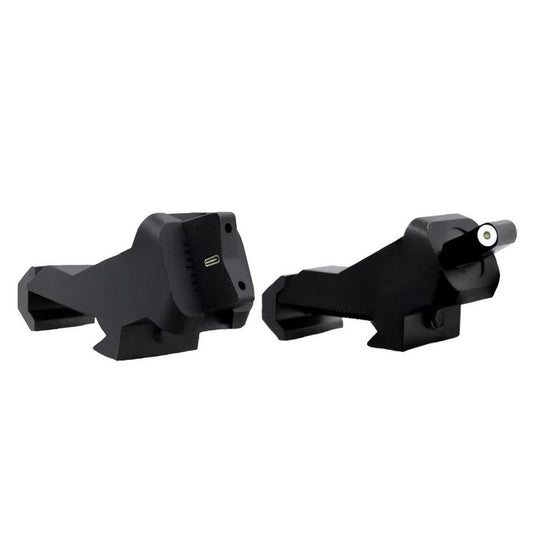

When you’re navigating a high-stakes environment, the XS SightXTI2 DXT 45 Degree Offset BUIS Big Dot Tritium Front & Rear sights become your trusted ally. With their highly visible white dot, these sights are designed for both bright and low-light shooting, ensuring that every shot counts. Powered by a tritium lamp, the front and rear sights glow in low-light conditions, offering you unmatched sight alignment precision. The V-Notch rear provides a low-profile design that enhances your visibility downrange, allowing for a clearer focus on your target.
What’s more, these sights feature a dot-the-"i" sight picture for optimal accuracy, complemented by a rear sight white outline that aids in quick identification. The easy-to-adjust windage ensures that you can maintain your accuracy even in changing conditions. Crafted from durable 6061 T6 aluminum, these sights are lightweight and ambidextrous, perfect for both right- and left-handed shooters. Installation is a breeze with top rail compatibility, making your setup straightforward and efficient. Get ready to elevate your shooting prowess!
Key Features:
- HIGH VISIBILITY with Big Dot for enhanced target acquisition in all lighting conditions.
- TRITIUM POWERED for seamless low-light shooting, ensuring you never miss a shot.
- V-NOTCH REAR design offers greater visibility of objects downrange for precision shooting.
- DOTTED "I" SIGHT PICTURE gives a clear alignment between your front and rear sights.
- REAR SIGHT ADJUSTABILITY allows for easy windage corrections on-the-fly.
- LIGHTWEIGHT MATERIAL made of 6061 T6 aluminum, minimizing overall rifle weight.
- FULLY AMBIDEXTROUS so both left-handed and right-handed shooters can enjoy optimal performance.
- EASY INSTALLATION with a top rail fit for all optic-ready AR-15 rifles.
Technical Specifications Table
| Specification | Details |
|---|---|
| Material | 6061 T6 Aluminum and CNC Steel |
| Weight | Lightweight |
| Installation Type | Top rail installation |
| Compatibility | Optic ready AR-15 rifles |
| Warranty | Lifetime, no questions asked |
What’s in the Box?
- Front and rear sights
- Installation hardware
- User manual
Customer Reviews
"These sights transformed my shooting! The visibility in low light is incredible!"
"Installation was straightforward, and I love that they're ambidextrous!"
"Perfect for my AR-15. Adjustments are easy, and they hold zero!"
FAQ
How do these sights perform in low light? The tritium-powered front and rear sights glow brightly in low light, making sight alignment quick and easy, which is crucial in critical situations.
Can I easily adjust the rear sight for windage? Absolutely! The rear sight is driftable, allowing you to make quick windage adjustments without fuss.
Are these sights durable enough for regular use? Yes, made with CNC steel and 6061 T6 aluminum, these sights are designed to withstand the rigors of duty use.
Similar Models
Looking for more options? Discover our extensive XS Sights lineup, including models like the XS Sight DXT2 Big Dot for enhanced visibility and XS Sights Standard Dot for a more traditional sighting system. Explore our full collection for the perfect optics tailored to your shooting needs.
You May Also Like
Here’s some of our most similar products people are buying. Click to discover trending style.






